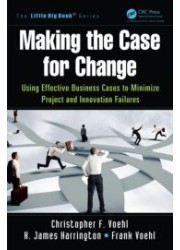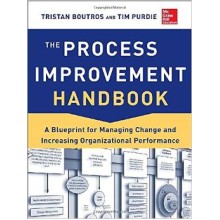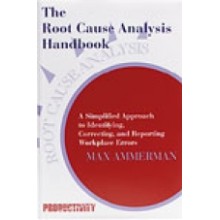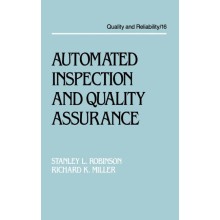Your shopping cart is empty!
Welcome visitor you can login or create an account
Making the Case for Change: Using Effective Business Cases to Minimize Project and Innovation Failures
Publisher: PRODUCTIVITY PRESS
ISBN: 9781466580510
Author: Christopher F. Voehl, H. James Harrington, Frank Voehl
Dispatch Time: In Stock
ISBN: 9781466580510
Author: Christopher F. Voehl, H. James Harrington, Frank Voehl
Dispatch Time: In Stock
Our Price: £28.99
Quantity:
-
Add to Compare
Business cases can be useful in relating various value propositions to the success of the organization. In developing business cases, value propositions are aligned with the organization's prioritization criteria and consolidated with the current initiatives. This book explains how to conduct a cost/benefit analysis and how to analyze risk and return of value propositions. It describes how to map value propositions against improvement matrices as well as how to prioritize value propositions. It also discusses how to review and approve initial business cases.
Getting Started with the Business Case—Activity 1: Set the Proposal Context and Stimulus
Introduction
Preparation Activities (PA): Initiating the Business Case Development (BCD) Process
Task PA 1: Prepare a Mission Statement and Select a BCD Team Leader
List of the Top 20 Attributes of an Effective BCD Team Leader
Task PA 2: Understanding the Role of the VPD Team
Task PA 4: Creating the Stimulus Blueprint
Inputs to the BCD Process
Activity 1: Set the Proposal Context and Stimulus
Task 1.1: Create the BCD Team
Task 1.2: Preparing the BCD Team
Task 1.3: Analysis of Proposed Project’s Input Documents
Task 1.4: Does the Proposal Meet the Required Ground Rules to Prepare a Business Case?
Task 1.5: If the Answer to 1.4 Is "No," Then Take Appropriate Action
Summary
Activity 2: Define the Sponsor’s Role and Test Alignment to Organizational Objectives
Introduction
Activity 2: Define the Sponsor’s Role and Test Alignment to Organizational Objectives
Task 2.1: Define the Business Case Sponsor’s Role in the BCD Process
Task 2.2: Align the Project/Initiative with Strategic Goals and Objectives
Summary
Activity 3: Prepare the BCD Team’s Charter and Output
Introduction
Task 3.1: Develop the BCD Team’s Charter
Task 3.2: Define the Business Case Final Report
Brief Explanation of the Sample Document Elements
Change Management Action Plan
Summary of Task 3.2
Summary
Reference
Activity 4: Patents and Other Intellectual Property Considerations
Introduction
Task 4.1: Is the Idea/Concept an Original Idea/Concept?
Questions to Ask to Protect against Copyright Problems
Internal Communications Issues
Task 4.2: Start The Patent/Copyright Process
Summary
References
Activity 5: Collecting Relevant Information/Data
Introduction
Alignment of Tasks in Chapters 5, 6, and 7
Resistance to Change
Implementation Costs
Task 5.1: Characterizing the Current State
Product or Service-Related Changes
Accuracy of Current State Measurements
Task 5.2: Characterizing Proposed Future State
Four Factors to Consider and the Common Positive and Negative Impacts
Estimating the Positive Impacts
Characterizing Projected Future State for a Proposed Product or Process Improvement Project
Product Future State
Characterizing Refinements to a Current Product
Characterizing the Replacement of a Current Product with New Product
Characterizing a New Product That Represents a New Product Line
Task 5.3: Define the Proposed Future State Assumptions
Task 5.4: Define the Implementation Process
Task 5.5: Define the Major Parameters Related to the Proposal
Task 5.6: Define the Quality and Type of Data to Be Collected and Prioritized
Factor 1: Measuring the Current State
Factor 2: Measuring the Future State after the Project Has Been Implemented
Types of Measures
Data Disciplines
Factor 3: Collecting Data to Estimate the Proposed Project’s Impact on the Parameters
Factor 4: Estimating the Cost of Defining and Implementing the Changes to the Process or the New/Refined Product
Task 5.7: Develop the Data Collection Plan
Business Case Research Relevance to Data Quality
Basic Components of Business Case Data Quality
Problems with Business Case Data Collection
Business Case Sampling
On the Cost of Sampling
Some Business Case Data Analysis Tools
Tools, Techniques, and Methods Used
Data Analysis Checklist
Step 1: Clearly Defined Goals
Step 2: Operational Definitions and Methodology
Step 3: Ensuring Repeatability, Reproducibility, Accuracy, and Stability
Step 4: Sampling, Stratification, and Prioritization
Tools, Techniques, and Methods Used
Task 5.8: Collecting Process/Product Installation-Related Data/Information
Collecting Product Related Data
Collecting Project/Initiative Implementation Data
Data Collection Summary
Summary
Reference
Activity 6: Projected Improvement Analysis
Introduction
Task 6.1: Characterize the Current State of the Parameters Identified in the Tasks Defined in Chapter 5
Task 6.2: Estimate the Degree of Change That Will Be Brought about as a Result of the Project for Each of the Affected Parameters
Case Study Number One
Task 6.3: Compare the Estimated Degree of Change to That Projected by the Individual or Group That Originated the Project
Task 6.4: Determine if the Improvement Justifies Continuing the Analysis
Case Study Number Two
Summary
Activity 7: Developing Proposed Project Recommendations, Estimates of Resources, and Return on Investment (ROI)
Introduction
Task 7.1: Develop an Estimate of Resources Required to Implement the Proposed Project
Parametric Model Estimation
Total Cost Estimation
Simulation Model Estimation
Reserve Analysis Estimation
PERT or 3-Point Estimation
Published Data Estimation
Analogous Estimation
Vendor Bid Analysis Estimation
Expert Judgment Estimation
Task 7.2: Perform a Sensitivity, Safety, and Risk Analysis and Develop Mitigation Plans
Sensitivity Analysis
Task 7.3: Calculate Value Added to the Organization
Task 7.4: Develop Proposed Project/Initiative Recommendations
Summary
Activity 8: Presenting the Business Case to the Executive Committee
Introduction
Task 8.1: Prepare the Business Case Final Report
Business Case Final Report Outline Summary
Executive Summary
Task 8.2: Set Up a Meeting with the Executive Team
Scheduling the Executive Team Meeting
Meeting Agenda
Preparation for Executive Team Meeting
Task 8.3: Present Findings and Recommendations to the Executive Team
Task 8.4: Project/Initiative Approval Decisions
Task 8.5: The Project/Initiative Is Approved
Task 8.6: Proposal Is Rejected
Task 8.7: Prepare an Initial Project Mission Statement
Task 8.8: Closure of the BCD Team
Summary
Summary of the Business Case Development Process
Appendix A
Appendix B
Appendix C
Appendix D
Index
Preparation Activities (PA): Initiating the Business Case Development (BCD) Process
Task PA 1: Prepare a Mission Statement and Select a BCD Team Leader
List of the Top 20 Attributes of an Effective BCD Team Leader
Task PA 2: Understanding the Role of the VPD Team
Task PA 4: Creating the Stimulus Blueprint
Inputs to the BCD Process
Activity 1: Set the Proposal Context and Stimulus
Task 1.1: Create the BCD Team
Task 1.2: Preparing the BCD Team
Task 1.3: Analysis of Proposed Project’s Input Documents
Task 1.4: Does the Proposal Meet the Required Ground Rules to Prepare a Business Case?
Task 1.5: If the Answer to 1.4 Is "No," Then Take Appropriate Action
Summary
Activity 2: Define the Sponsor’s Role and Test Alignment to Organizational Objectives
Introduction
Activity 2: Define the Sponsor’s Role and Test Alignment to Organizational Objectives
Task 2.1: Define the Business Case Sponsor’s Role in the BCD Process
Task 2.2: Align the Project/Initiative with Strategic Goals and Objectives
Summary
Activity 3: Prepare the BCD Team’s Charter and Output
Introduction
Task 3.1: Develop the BCD Team’s Charter
Task 3.2: Define the Business Case Final Report
Brief Explanation of the Sample Document Elements
Change Management Action Plan
Summary of Task 3.2
Summary
Reference
Activity 4: Patents and Other Intellectual Property Considerations
Introduction
Task 4.1: Is the Idea/Concept an Original Idea/Concept?
Questions to Ask to Protect against Copyright Problems
Internal Communications Issues
Task 4.2: Start The Patent/Copyright Process
Summary
References
Activity 5: Collecting Relevant Information/Data
Introduction
Alignment of Tasks in Chapters 5, 6, and 7
Resistance to Change
Implementation Costs
Task 5.1: Characterizing the Current State
Product or Service-Related Changes
Accuracy of Current State Measurements
Task 5.2: Characterizing Proposed Future State
Four Factors to Consider and the Common Positive and Negative Impacts
Estimating the Positive Impacts
Characterizing Projected Future State for a Proposed Product or Process Improvement Project
Product Future State
Characterizing Refinements to a Current Product
Characterizing the Replacement of a Current Product with New Product
Characterizing a New Product That Represents a New Product Line
Task 5.3: Define the Proposed Future State Assumptions
Task 5.4: Define the Implementation Process
Task 5.5: Define the Major Parameters Related to the Proposal
Task 5.6: Define the Quality and Type of Data to Be Collected and Prioritized
Factor 1: Measuring the Current State
Factor 2: Measuring the Future State after the Project Has Been Implemented
Types of Measures
Data Disciplines
Factor 3: Collecting Data to Estimate the Proposed Project’s Impact on the Parameters
Factor 4: Estimating the Cost of Defining and Implementing the Changes to the Process or the New/Refined Product
Task 5.7: Develop the Data Collection Plan
Business Case Research Relevance to Data Quality
Basic Components of Business Case Data Quality
Problems with Business Case Data Collection
Business Case Sampling
On the Cost of Sampling
Some Business Case Data Analysis Tools
Tools, Techniques, and Methods Used
Data Analysis Checklist
Step 1: Clearly Defined Goals
Step 2: Operational Definitions and Methodology
Step 3: Ensuring Repeatability, Reproducibility, Accuracy, and Stability
Step 4: Sampling, Stratification, and Prioritization
Tools, Techniques, and Methods Used
Task 5.8: Collecting Process/Product Installation-Related Data/Information
Collecting Product Related Data
Collecting Project/Initiative Implementation Data
Data Collection Summary
Summary
Reference
Activity 6: Projected Improvement Analysis
Introduction
Task 6.1: Characterize the Current State of the Parameters Identified in the Tasks Defined in Chapter 5
Task 6.2: Estimate the Degree of Change That Will Be Brought about as a Result of the Project for Each of the Affected Parameters
Case Study Number One
Task 6.3: Compare the Estimated Degree of Change to That Projected by the Individual or Group That Originated the Project
Task 6.4: Determine if the Improvement Justifies Continuing the Analysis
Case Study Number Two
Summary
Activity 7: Developing Proposed Project Recommendations, Estimates of Resources, and Return on Investment (ROI)
Introduction
Task 7.1: Develop an Estimate of Resources Required to Implement the Proposed Project
Parametric Model Estimation
Total Cost Estimation
Simulation Model Estimation
Reserve Analysis Estimation
PERT or 3-Point Estimation
Published Data Estimation
Analogous Estimation
Vendor Bid Analysis Estimation
Expert Judgment Estimation
Task 7.2: Perform a Sensitivity, Safety, and Risk Analysis and Develop Mitigation Plans
Sensitivity Analysis
Task 7.3: Calculate Value Added to the Organization
Task 7.4: Develop Proposed Project/Initiative Recommendations
Summary
Activity 8: Presenting the Business Case to the Executive Committee
Introduction
Task 8.1: Prepare the Business Case Final Report
Business Case Final Report Outline Summary
Executive Summary
Task 8.2: Set Up a Meeting with the Executive Team
Scheduling the Executive Team Meeting
Meeting Agenda
Preparation for Executive Team Meeting
Task 8.3: Present Findings and Recommendations to the Executive Team
Task 8.4: Project/Initiative Approval Decisions
Task 8.5: The Project/Initiative Is Approved
Task 8.6: Proposal Is Rejected
Task 8.7: Prepare an Initial Project Mission Statement
Task 8.8: Closure of the BCD Team
Summary
Summary of the Business Case Development Process
Appendix A
Appendix B
Appendix C
Appendix D
Index
Write a review
Your Name:Your Review: Note: HTML is not translated!
Rating: Bad Good
Enter the code in the box below:
Price subject to change without notice
Copyright © 2014 Engineering Standards Bureau. All Rights Reserved.
Developed By Zoom Into Web
Copyright © 2014 Engineering Standards Bureau. All Rights Reserved.
Developed By Zoom Into Web







